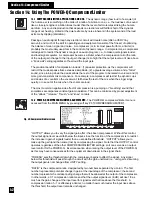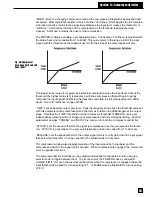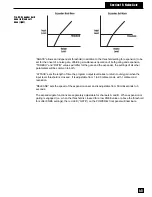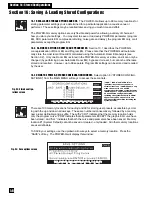
15.1 EXPANDER/NOISE GATE APPLICATIONS AND USE.
Just as compression is designed to restrict the
extremes of the dynamic range of an audio program, an expander is designed to
increase dy-
namic range. In normal usage, the dynamic range is increased by downward expansion, i.e., by
turning down quiet signals to a lower level. The most common application is to reduce noise in a
program, as the noise will generally be quieter than the signal. Any audio that falls below a gain
threshold will be turned down; when it is turned down so far as to be turned off, the expansion
function is known as a gate. Since the turned off/turned down audio is generally undesirable noise
(tape hiss, component noise, guitar amplifier noise, leakage from an off-mic sound source, etc.),
any device that automatically turns off such noise has come to be called a “noise gate.”
The major problem when using expanders and gates occurs as the audio crosses the gain
threshold, engaging the expansion. An abrupt change from “on” to “off” or vice versa can produce
an audible pop or click and tends to be more of a problem as audio signals sustain and decay.
For audio with a slower attack (such as bowed string instruments), the gate may also abruptly
open in mid note. For human speech, a gate may cut off the beginnings of consonant sounds.
For this reason, you must exercise care in the setting of the gate’s threshold, knee, attack and
release parameters. If you are using the POWER-Q as an insert point of a mixer channel, the
settings may be less critical than for using the POWER-Q between a mixer and an amplifier,
where you run the risk of abruptly turning off low level portions of your mix via poor gate settings.
15.2 POWER-Q EXPANDER/NOISE GATE ADJUSTMENTS.
The POWER-Q expander/gate is accessed by
pressing soft key #6 from the MAIN MENU (“EXPANDER/NOISE GATE”). The window looks like
this:
Many of the EXPANDER/NOISE GATE parameters are essentially identical to COMPRESSOR/
LIMITER adjustments, only they act in reverse fashion.
“THRESH” sets the level at which the expander turns on and off. It is adjustable from -90 dBu
(off) to -20 dBu peak.
“RATIO” is the expansion ratio. The first number represents a change in gain at the input stage of
the expander; the second number represents the corresponding decrease in gain for the output of
the expander when the input level falls below the threshold. In other words, a 1:3 expansion ratio
means that the output level of the expander will fall three times as quickly as the input level for
signals that fall below the threshold. An expansion ratio of 1:
4
is a noise gate; signals that fall
below the threshold will be turned down completely.
“KNEE” refers to the slope of the gain reduction that occurs as the threshold of the expander is
approached. A value of 1 (the “hardest” knee) will simply turn on and off immediately as the
threshold is crossed. Higher values will “soften” the knee with an accelerating onset of expansion
as the input level approaches the gate threshold. This “softens” the turn-on and turn-off of the
gate. A setting of “40” will begin to gently expand the signal 20dB above the threshold and
achieve the full expansion ratio 20dB below the threshold.
Section 15: Using The POWER-Q Expander/Noise Gate
44
Section 15: Noise Gate
Fig. 51: Noise gate/
downward expander
screen
















































